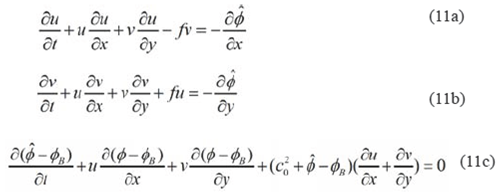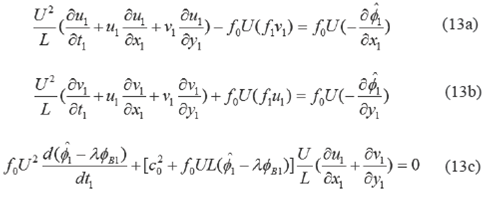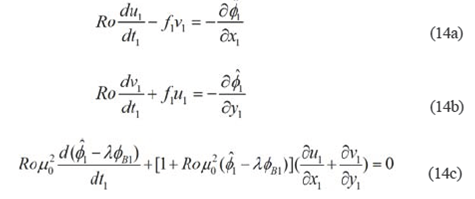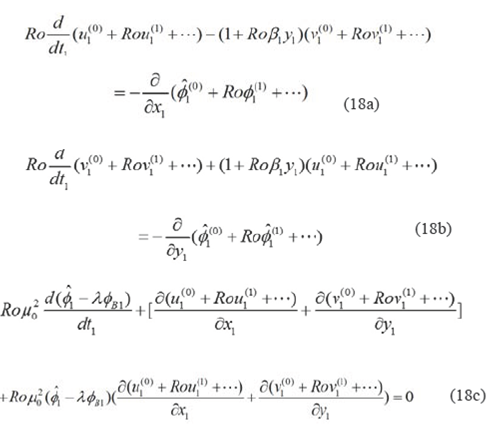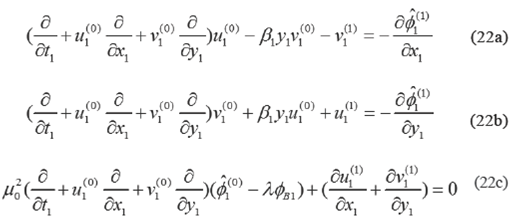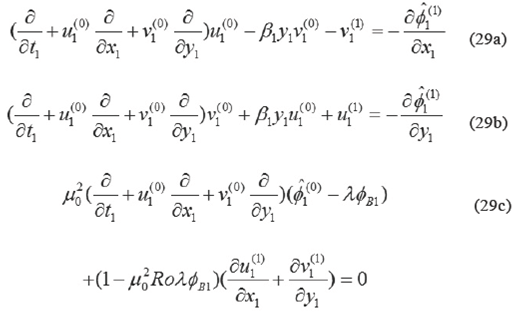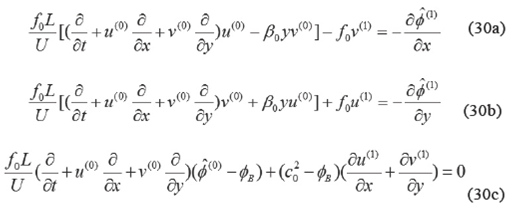1. Introduction
In recent decades, many scholars have conducted extensive research on large-scale atmospheric and oceanic dynamics. Among them, the topographic effect has great influences on the dynamic mechanism of potential vorticity equations (Pedlosky, 1974; Collings, 1980; Pedlosky, 1980; Treguier, 1989). In the atmosphere, the topographic height plays an importance role in atmospheric cyclone and anticyclone changes. Luo (1990) pointed out the topographic effect was also an important factor of forming atmospheric blocking, and the global atmospheric circulation would even get affected by the topographic effect. Lu (1987) discussed the effects of topographic height and shaped on Rossby wave activation and the influences of topographic south-north and east-west slopes on waveform and energy propagation. Chen (1998) and Jiang (2000) derived the quasi-geostrophic potential vorticity equation with large-scale topography, friction, and heating under the barotropic model, and the large-scale effects of Qinghai-Tibet Plateau on atmosphere were discussed. In addition, the oceanic topography is very complex, such as The North West Shelf of Australia (Holloway, 1997), Portugal Shelf Sea Area (Sherwin, 2002), etc. The relationship between topography and ocean circulation was pointed out in the literature (Roslee et al., 2017b; Kamsani, 2017; La, 1990; Marshall, 1995; Alvarez, 1994; Sou, 1996). Cessi (1986) discussed the important role of topography in ocean circulation. Holloway (1992) introduced the interaction of eddies with seafloor topography and argued that ocean circulations would be significant interaction between turbulent vortices and topography rather than gravity wave drag. Then, general expressions for the eddy-topographic force, eddy viscosity, and stochastic backscatter, as well as a residual Jacobian term, are derived for barotropic flow over mean topography by Frederiksen (1999). All the above researches, Actually the topography height also changes with time in the earth fluid. Changes in topography can lead to tsunamis, floods and natural disasters(Abdullah, 2017; Elfithri, 2017; Rahim, 2017). Yang (2011,2012) and Song (2012, 2013) discussed topography changes over time discussed topography changes over time t, the influence of the nonlinear long wave amplitude and waveform. Da (2013) discussed the shallow water equation forms when underlying surface slowly changes with time and obtained the vorticity equation with an underlying surface. This model considered the actual circumstances that the topography changes with time-space (Erfen et al., 2017; Roslee, 2017a) . In this paper, we discuss different magnitude topography under spatial-temporal variable and obtain some modiied models, which have important effects on the future discussion about the waveform changes of nonlinear long waves.
This paper is organized as follows: In Section 2, starting from the rotating shallow water equation set, we give the bottom topography which is not smooth boundary and simplify the equation set with unsteady topography. Section 3 is given scale analysis and perturbation methods; then we obtain new equation set by topographic conditions with different magnitudes. Later we derive the equations with different orders and get some modified models in Section 4. Finally, make the relevant conclusions in Section 5.
2. Basic equations
Assuming the static equilibrium condition, the fluid can be regarded as barotropic, incompressible, frictionless state. The upper boundary height is h(x,y,f), and  surface pressure intensity
surface pressure intensity  is constant. The basic equation set can be written as (Pedlosky, 1987)
is constant. The basic equation set can be written as (Pedlosky, 1987)
especially, the bottom topography is about spatial-temporal variable
hB = hB(x, y, t) ,
the coriolis parameter is
first of all, we integrate Eq. (1c)
and get
So
Eqs. (5) and (6) indicate that the horizontal pressure gradient under the barotropic model can be expressed by the gradient of the free surface gravitational potential (Taharin & Roslee, 2017).
We assume that the preliminary horizontal velocity is independent of the z , Eqs. (1a) and (1b) can be rewritten as
then integrate continuity Eq. (Id) from z = hB(x,y,t) to the free surface z = h( x, y, t), we can get
assuming that the free surface height H is constant when the fluid is static (Pedlosky, 1987).
the barotropic equation set with unsteady topography can be written as
If
the equation set can be written as
3. Scale analysis, perturbation methods
Making dimensionless analysis on the Eqs. (11a), (11b) and (11c), for the large-scale motions
where l is an undetermined parameter.
Substituting Eq. (12) into Eqs. (11a), (11b) and (11c), then
Eqs. (13a) and (13b) divided by  , (13c) divided by
, (13c) divided by  , we get
, we get
where
Let
then we get
where
4. Derive the barotropic models
Making classified discussion on the magnitude of λ
4.1. λ ~ 1 magnitude
The scale of the ϕB is consistent with the small amplitude function ϕ most of the topography parameters following with this situation in the real world.
Ro 0 order approximation
or a dimensional form
Ro 1 order approximation
after calculation, the dimensionless vorticity equation is derived
eliminating  from the Eqs. (23a), (23b), we get
from the Eqs. (23a), (23b), we get
namely
where
λR is the Rossby radius of deformation, Eq. (25) is a modified model.
4.2. λ ~ 10 magnitude
Large-scale atmospheric motion of large topography is suitable for such conditions (L ~ 106 m, U ~ 10m/s, f 0 ~ 10-4 s -1 ). For example, a case study of Tibetan Plateau topography, the height is 3 4 x103m approximately which is suit for the situation.
Ro 0 order approximation
or a dimensional form
in order to get the results, we should consider the magnitude of 
 , according to the Eq. (18c),
, according to the Eq. (18c),  can be considered as a parameter.
can be considered as a parameter.
Ro 1 order approximation
or dimensional form
Eqs. (30a), (30b) and (30c) can be transformed into the vorticity equations
Eqs. (31a), (31b) are quasi-geostrophic barotropic models, so
where
assuming  , we eliminate
, we eliminate  from Eqs. (32a) and (32b), then
from Eqs. (32a) and (32b), then
Finally
Eq. (35) is a modified model.
4.3. λ ≤ 10 -1 magnitude
According to (18c), it is observed that the magnitude of topography expression form λ is too small, which approximately ignores the influences of topographic effect.
Now we can observe that the Eqs. (25), (35) are two quasi-geostrophic barotropic models under variable topographic conditions with time t. If the topographic effect is independent of time, equations degrade into the following forms.
Under the stable topography, Eq. (35) degenerates into
where
the model (25) under the stable topography can be written as (Pedlosky,1987)
where
otherwise, if we don’t consider the topographic effect and the divergence of the fluid, Eqs. (36) and (38) degenerate into (Liu, 1991)
Eq. (40) is a classics dynamics model used by the large-scale atmospheric and oceanic motions.
5. Conclusion
(a). Under the unsteady topography, some new modified models (25), (35) are derived. These models meet the general rule that the topography changes with time in reality. When the topography has nothing to do with the time, Eq. (35) degenerates into a dynamics model (36), Eq. (25) degenerates into Eq. (38) which is a quasi-geostrophic barotropic model under the spatial topography.
(b). The modified models under the topographic effect with different magnitudes are presented, we can see the pattern under the condition of large terrain, which is the improvement of the model. After the above-modified models are given, we will also derive the mathematical model for Rossby wave in the further study, and the further exploration of the large-scale factual influences of topography on atmosphere and ocean are required.






























